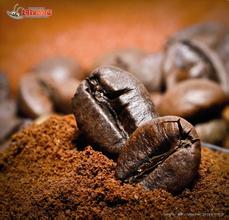Ethiopian coffee history, culture, development Ethiopian coffee beans and Kenyan coffee beans
Coffee ceremony in Ethiopia (one of the African Chronicles)
Before Christmas in 2004, Ethiopia, known as the "roof of Africa", was invited by a friend to do three weeks of technical consultation. At that time, Africa was still regarded as a dangerous region by Chinese people. Before leaving, PICC Wuxi Company asked for instructions from Wuxi Company to Nanjing, and finally told me that there was nothing I could do to help. No way, I had promised my friend, so I had to board the Ethiopian Airlines flight that stopped in Delhi, India. During my three-week field life in the Ethiopian capital plateau city of Addis Ababa, apart from the unique African plateau scenery and many deja vu municipal road styles built by the Chinese, what impressed me most was the local coffee ceremony.
In the past, it was only known that coffee originated in Africa, and later spread to South America for cultivation and development. in fact, the "Kafa" state of Ethiopia is the real hometown of coffee. It is said that most of the coffee species in the world come from this place, and even the ingredients of the world's famous brands of instant coffee have coffee beans from this land.
There, drinking coffee does not have to go to high-spending places such as cafes and hotels, just like drinking tea in China, you can enjoy it at any time. Needless to say at home, in the company, or even in the factory
There is also a coffee time and a specific coffee ceremony in the room, which is locally known as "coffee ceremony". Just like our Asian tea ceremony, I think what local people really enjoy in the coffee ceremony may not be drinking coffee itself, but the process of brewing and drinking coffee with some religious rules. The ancient and simple ceremony not only makes people feel the pleasure of tasting authentic coffee, but also makes the participants experience the long tradition of local reverence for coffee.
The coffee ceremony in Ethiopia began when the hostess laid a 2mur3 square meter floor with a local grass, followed by a small stove for roasting coffee beans and a small table for coffee utensils.
Then there is the washing of coffee beans. First take a bowl of light green coffee beans, wash them in a small basket, just like we wash rice, wash them, take them out and spread them flat on a slightly concave iron plate, then put the iron plate on a small stove fueled by wood or charcoal and start baking. During the baking process, the hostess fiddled with a curved iron bar from time to time. As the temperature increased, the color of the coffee beans changed from light green to golden yellow, and the evaporated coffee beans began to crack and give off a faint fragrance, just as we usually smell in cafes, but much lighter. After roasting, the coffee beans turn dark brown and the aroma becomes stronger.
After baking, the next step is to crush the coffee beans. The hostess withdrew the iron plate to the outside of the stove, cooled slightly, poured the roasted coffee beans into an iron mortar about 30 centimeters high, similar to our processed traditional Chinese medicine, and hammered the beans into coffee powder with an iron pestle. This action is not as simple as it seems. One hand should be held on the iron mortar below, and the other hand should be raised high, because only by holding it high can one be able to do so. To force the iron pestle accurately into the small mouth of the iron mortar, inexperienced people will only hit their own hands. I have also asked curiously, why not grind coffee in an iron mill or a coffee machine? The host told me that if grinding with a machine, the high-speed friction between coffee beans and metal brings a lot of impurities on the iron, which will affect the pure flavor of the coffee after processing.
After the coffee powder is made, the hostess carries the clay plate containing the coffee powder and sends it to the guests attending the ceremony in turn, so that everyone can smell the incense. Next, pour the Chung-ho coffee powder into a clay high-necked coffee pot, add water and boil it on a charcoal stove. on the high neck of the coffee pot, there is a special cork shaped like a wooden top played by children, but a bit like a shoddy one. The function of cork is to keep warm, because the local elevation is more than 2500 meters, the boiling temperature of coffee liquid is low, and the kettle is open, which is not conducive to keeping the temperature; second, it is boiling coffee.
Steam can be easily flushed out of the cracks in the cork. Since they are all made of natural materials, the coffee brewed is naturally more fragrant.
While brewing coffee, there is a porcelain fumigation on the side, which contains a white powder. Only after inquiry did I know that this is a material called mo4 medicine in a traditional Chinese medicine store. After the porcelain fumigation is heated, there is a curl of aroma coming out, which is mixed with the strong aroma of the coffee pot and spreads in the room, creating a unique atmosphere. The locals proudly told me that only coffee drunk in this atmosphere can be regarded as authentic Ethiopian coffee.
The coffee (which is called "Buna" in the local official Amharic language) is made, and before tasting the coffee, there is a snack. The hostess brings a plate of refreshments (usually bread or cake) and a dessert knife to the guests, who cut the refreshments, which is a bit like slicing a birthday cake. This may be what we call coffee companions today.
When the guests all picked up the refreshments, the highlight of the coffee ceremony began. The hostess poured the rich coffee liquid from the coffee pot into a small ceramic or magnetic coffee cup like us drinking Kungfu Tea on the small table, and gave it to the guests one by one on a tray, with a small clay jar containing granulated sugar. Guests can take it as they like.
Local people like to add a lot of sugar to their coffee, perhaps because their coffee is particularly rich and bitter.
The first coffee is called "Abu" in Amharic, and it has a strong flavor. Although there is only a small cup, it makes people excited after drinking it, and it feels completely different from the instant coffee drunk in China. In contrast, instant coffee is lighter, like a cup of tea, while "Abramovich" is thicker, that is, a cup of wine. This is a drink that keeps the aroma of coffee in the mouth for a long time.
After the first course, the hostess added some more water to the pot and continued to boil. Soon the second course of coffee, "Tona", will be available. "Tona" tastes a little lighter, but more mellow. I have a good feeling about this. Because it is not too bitter, does not need to add a lot of sugar, but also rich in the original taste of coffee, can be tasted carefully.
The third course of coffee is called "Boca", which is much lighter by comparison and is coming to an end.
Tasting authentic Ethiopian coffee around the stove, primitive, simple and leisurely, elegant coexistence, coupled with the host's pious performance and warm reception, to paraphrase a popular slogan, this is "delicious". The weekly coffee ceremony made me very interested in the local coffee ceremony. Before returning home, the hostess must give me a full set of brewing.
Coffee utensils and, of course, authentic Ethiopian Arabica coffee beans. I really like the coffee pot and porcelain fumigation made of simple clay pottery, and when choosing coffee cups, although I prefer the black local clay cups, she insists on giving me fine porcelain cups. She says this is better, smoother, durable and more valuable for artistic appreciation.

Important Notice :
前街咖啡 FrontStreet Coffee has moved to new addredd:
FrontStreet Coffee Address: 315,Donghua East Road,GuangZhou
Tel:020 38364473
- Prev

Grade Analysis of Ethiopian Coffee beans
Ethiopian coffee beans are divided into five levels. The first and second stages are washed beans. Washed beans Grade1 represents 3 defective beans per 300g raw beans, and Grade2 represents 4 defective beans per 300g. Gradc1 grade water washed beans are very rare and are generally difficult to buy. At present, all the washed beans exported from Ethiopia are Grade2 grade. The quality of sun-dried beans is Grade3 and Grad in order.
- Next

Ethiopian Coffee introduces Ethiopian Harald mocha coffee beans
Ethiopia Harald mocha beans (Ethiopian Harar mocha) roast taste and photo photo light roasted Harald coffee beans, brewed in a siphon coffee pot, really have a hint of citrus aroma! This Harald harar raw coffee bean looks like grade 5, irregular, long beans (longer flat beans), short flat beans, round beans, boiled beans
Related
- Does Rose Summer choose Blue, Green or Red? Detailed explanation of Rose Summer Coffee plots and Classification in Panamanian Jade Manor
- What is the difference between the origin, producing area, processing plant, cooperative and manor of coffee beans?
- How fine does the espresso powder fit? how to grind the espresso?
- Sca coffee roasting degree color card coffee roasting degree 8 roasting color values what do you mean?
- The practice of lattes: how to make lattes at home
- Introduction to Indonesian Fine Coffee beans-- Java Coffee producing area of Indonesian Arabica Coffee
- How much will the flavor of light and medium roasted rose summer be expressed? What baking level is rose summer suitable for?
- Introduction to the characteristics of washing, sun-drying or wet-planing coffee commonly used in Mantenin, Indonesia
- Price characteristics of Arabica Coffee Bean Starbucks introduction to Manning Coffee Bean Taste producing area Variety Manor
- What is the authentic Yega flavor? What are the flavor characteristics of the really excellent Yejasuffi coffee beans?

